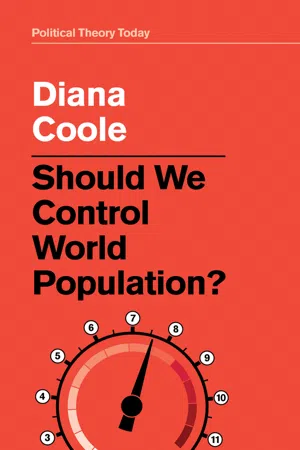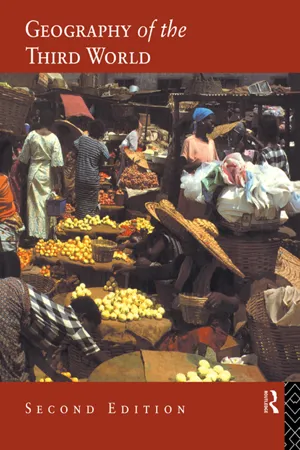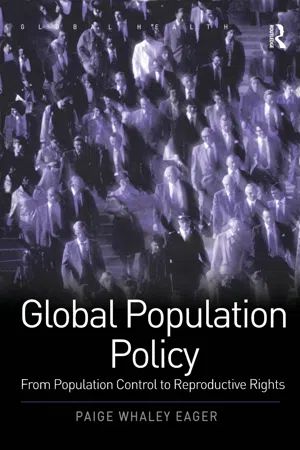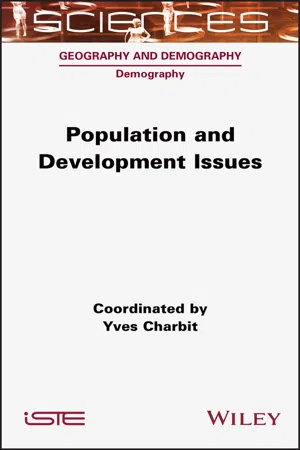Geography
Population Control
Population control refers to the measures and policies implemented to regulate the size, distribution, and growth of a population. These measures can include family planning, birth control, immigration restrictions, and incentives for smaller families. The goal of population control is often to manage resources, reduce environmental impact, and improve quality of life.
Written by Perlego with AI-assistance
Related key terms
5 Key excerpts on "Population Control"
- eBook - ePub
An Introduction to Population Geographies
Lives Across Space
- Holly R. Barcus, Keith Halfacree(Authors)
- 2017(Publication Date)
- Routledge(Publisher)
There is a clear prima facie case for the discipline of Demography : “the scientific study of the size, composition, and distribution of human populations and their changes resulting from fertility, mortality, and migration” (Poston and Bouvier 2010: 3). Births, deaths and human migrations between locations across the globe certainly require measurement, presentation and discussion, and future trends predicted. But whilst Demography also involves itself with the causes of the patterns, trends and magnitudes it identifies—“the factors that affect these components” (Poston and Bouvier 2010: 3)—a more dedicated emphasis on their contextualized spatial expression has become the focus of Population Geography. 1.2.2 … across real places Population Geography can be defined initially as the study of “the geographical organization of population and how and why this matters to society” (Bailey 2005: 1). An immediate illustration of how such a spatial lens is both significant and important comes, once again, via some simple demographic facts about the state of the world today (developed more fully in Chapter 3). Consider infant mortality rates (10.3.1) in a small selection of countries in Asia and Europe, shown in Table 1.1. First, even across these ten countries there is a considerable range of values. This is true even within the same continent, such as the contrast between Romania and Norway in Europe. Second, although there is a general trend towards declining infant mortality, countries such as Mongolia and India retain extremely high rates. Furthermore, many countries affected by civil strife, such as Afghanistan, Congo or Iraq, are understandably unable to provide data. Thus, Table 1.1 is biased in favor of countries experiencing relative political stability - eBook - ePub
- Diana Coole(Author)
- 2018(Publication Date)
- Polity(Publisher)
1Should Population be Controlled?Given the impact of population change, is it in societies’ interests to control it? This chapter concentrates on the broader question of demographic ends. Demographic ends, or goals, concern policies that address a population’s growth rate, size and density. Economists, demographers and environmentalists are the principal players in this ‘numbers game’, in which natural resources, economic development/ growth and technological capabilities are especially salient elements. Normative judgements about the quality of life (the wider existential purpose served by managing numbers) are important, too, albeit often dismissed on the grounds that they are difficult to measure or quantify.Because Population Control is usually associated with (‘neo-Malthusian’) efforts to limit fertility in order to reduce growth rates, the chapter mainly focuses on consequentialist arguments for anti-natalist initiatives. It is important to bear in mind, however, that even among advocates of population policies there are disagreements about their direction: that is, whether the aim should be fewer or more people, and thus whether national governments should pursue anti- or pro-natalist policies. This partly reflects the context-sensitive nature of changing demographic impacts, which vary as economic and environmental conditions alter. But it also expresses deeper disagreements about sustained versus limited growth, competing models of wealth creation and development, disputes over how best to achieve environmental sustainability and intergenerational justice, and conflicts over anthropocentric versus biocentric ontologies.Contrary to some popular misconceptions, Population Control does not mean culling superfluous people. The aim is to reduce current birth rates in order that smaller future generations might live better. This was essentially Malthus’s point in his Essay on the Principle of Population - eBook - ePub
- C.G Clarke, Dr J P Dickenson, J.P Dickenson, W.T.S Gould, S Mather, Sandra Mather, Prof R Mansell Prothero, R.M Prothero, D.J Siddle, C.T Smith, Mr C T Smith, E. Thomas-Hope(Authors)
- 2013(Publication Date)
- Routledge(Publisher)
The circumstances of foreign migrant labourers are always precarious. They are liable to be expelled or repatriated, particularly if they may have entered the host country illegally, and illegal status means they may be exploited by the payment of low wages, and lack access to social security provisions. In West Africa in the 1970s and 1980s foreign workers became the scapegoats for deteriorating economic conditions, and there were major expulsions from many countries, notably from Nigeria in 1983 and 1985 following the downturn in its oil-based economy. Migrants may also find themselves in war zones or in civil disruption, as were migrant labourers in Kuwait at the time of the Gulf War in 1991.Factors in Population ControlFamily planning and control have figured more importantly than any other element in discussions concerning population in the Third World in recent decades – with various and often vigorous reactions. Planning and control have been considered only in terms of limiting or reducing population, whereas they should be seen more objectively as the means whereby the social and economic potential of people may be fulfilled both nationally and individually. The planning and control of population are very emotive issues about which it is difficult to be objective, and reactions are influenced by political, religious, cultural, social and economic factors.Problems of population on a global scale, and in the Third World in particular, have become a major concern since the 1950s. Sufficient data have become available through national and international organizations to make fully evident the magnitude and implications of population growth. These organizations include national census offices and institutes for population studies, with international involvement within the United Nations (e.g. the Population Division of the Economic and Social Council) and its special agencies (e.g. World Health Organization, Food and Agricultural Organization, World Food Programme, UNICEF). In the 1970s the UN Fund for Population Activities (UNFPA) was set up specifically as a focus for work on population: to provide support for better and more coordinated investigations and to seek ways and means of alleviating and possibly solving the wide-ranging problems which populations present. It was felt that pressures of population in many parts of the Third World could be reduced if political, social and economic structures were modified, but cultural, religious and political differences do not make consensus between states on population matters easy: for more than two decades after it was set up the World Health Organization was not allowed any direct involvement in aspects of Population Control. - eBook - ePub
Global Population Policy
From Population Control to Reproductive Rights
- Paige Whaley Eager(Author)
- 2017(Publication Date)
- Routledge(Publisher)
Chapter 2 Population Control as Global PolicyIntroduction
This chapter will explore how Population Control, as the dominant norm guiding global population policy, was diffused internationally from 1965 to 1973. The United States, as an actor with agency, effectively propagated the norm of Population Control as critical to third world development from the period of 1965 to 1973. Through the Population Control establishment, which was largely based in the United States and a few other developed countries, the United States worked bilaterally and multilaterally to socialize other countries into accepting the need for Population Control measures. During this time, both the executive and legislative branches were in support of generously funding international Population Control programs. Moreover, domestic consensus within the United States supported the idea that development for the world’s poor would occur only when fertility rates began to decrease. Demographers, politicians, and the donor community supported Population Control measures without giving much thought as to how these policies affected women’s health and rights. Although resistance from the developing world was apparent in regard to implementing Population Control measures, the developing world had few avenues through which to express its views. For example, the 1965 gathering on world population in Belgrade, Yugoslavia was primarily attended by demographers and not governments. Only in 1974 would the international community have the opportunity to convene in a global forum to discuss world population and effectively challenge the norms the United States sought to disseminate, internationalize, and institutionalize regarding the causal relationship posited between population and development.Throughout human history, it was generally accepted that a growing population was vital to a society’s military and economic strength. However, by the mid-1960s, the ‘problem’ of rapid population growth, especially in the developing world, began to affect the institutions of the international system. The heretofore common stock of knowledge that a growing population is consistent with state strength began to be questioned. Moreover, the new ‘ideational structure’ that population growth can be negative, especially in the developing world, affected the interests and identity of the United States. The United States prior to the mid-1960s was adamantly opposed to becoming involved in the business of birth control within the United States, let alone in the developing world. However, by 1968 with the publication of the Ehrlichs’ The Population Bomb - eBook - ePub
- Yves Charbit(Author)
- 2022(Publication Date)
- Wiley-ISTE(Publisher)
actions taken explicitly or implicitly by public authorities, in order to prevent, delay, or address imbalances between demographic changes, on the one hand, and social, economic, [environmental] and political goals, on the other” (May 2012, p. 2). The ultimate goal of population policies is to adjust the population size and age structure to the needs and aspirations of the people. However, there is an ongoing debate about whether and how public authorities should intervene in population patterns and trends and, by implementing population policies, correct the imbalances caused by the increase or decrease of population and changes in the age structures. Despite a rather large consensus in favor of population interventions, some scholars have argued that it might be better to let natural and self-regulatory mechanisms, if any, do their work (Demeny 1986). However, other researchers have questioned the effectiveness and even the usefulness of population policies (Vallin 2016).Nonetheless, there has always been a large consensus in favor of policy interventions to reduce mortality. Furthermore, recent decades have also seen the strengthening of arguments in favor of fertility reduction and voluntary family planning, although some SSA governments have been reluctant to promote large-scale family planning programs (May 2012, 2017a). On the contrary, there is much less consensus in the more developed countries regarding the effectiveness of pronatalist policies, which public authorities have often been reluctant to implement. Moreover, population distribution policies, that is, programs to relocate populations in order to reduce population pressure in the migrants’ regions of origin, have been controversial (such a transmigration program was implemented in Indonesia between 1974 and 1994; see May (2012)). It should be kept in mind that demographic trends are essentially the result of decisions people make as couples or as individuals, with the overall aim being the achievement of household and/or personal goals. At the societal level, however, these individual decisions can have adverse or positive effects, which economists have labeled externalities. Negative externalities result when societal costs are out of line with those that are taken into account by individuals, that is, when the costs to society are greater than the costs supported by individuals. For example, high fertility levels may bring wealth and power to some families, but jeopardize the well-being of the community and its physical environment by depleting natural resources, causing deforestation in the case of agrarian societies, or aggravating unemployment, poverty and chaotic urbanization in the case of more industrialized societies (Pebley 1998).
Index pages curate the most relevant extracts from our library of academic textbooks. They’ve been created using an in-house natural language model (NLM), each adding context and meaning to key research topics.




